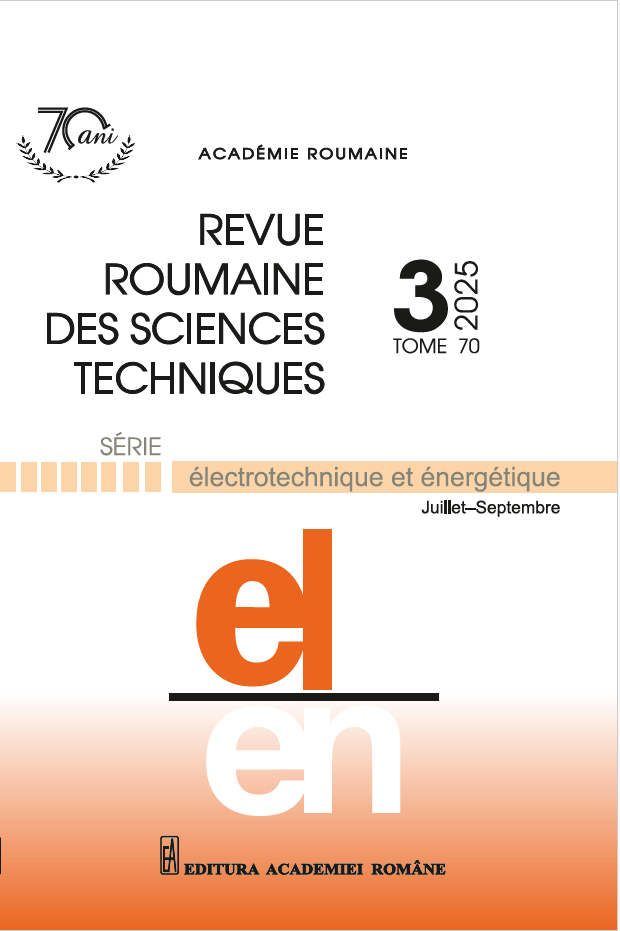MODELING OF ALBEDO FOR USVS' POWERED BY RENEWABLE SOURCES IN VARIABLE HYDROMETEOROLOGICAL CONDITIONS
DOI:
https://doi.org/10.59277/RRST-EE.2025.3.10Keywords:
Unmanned surface vehicles (USV), Photovoltaic cell, LabVIEW simulation, Wind speed, Wave heightAbstract
This study introduces an innovative mathematical model developed to calculate albedo as a function of wave height and wind speed, two critical parameters that enhance the efficiency of photovoltaic panels used by unmanned surface vehicles (USVs) in dynamic hydrometeorological conditions. Albedo, defined as the proportion of energy reflected by a surface, significantly impacts the conversion of solar radiation into electrical power. The proposed model underwent validation through both simulations and experimental measurements using LabVIEW and DIAdem tools, demonstrating a 96% accuracy under real-world conditions. These results confirm the model's effectiveness in forecasting energy output and optimizing energy management for autonomous maritime operations.
References
(1) X. Zhao, C. Liu, J. Zhao, Adaptive sliding mode-based fault-tolerant tracking control of multi-USV systems, 34th Chinese Control and Decision Conference (CCDC), pp. 5980–5985 (2022).
(2) S. Song, X. Guo, F. Xu, Z. Wang, Y. Xie, Y. Wu, Research on modeling of USV swarm target defense mission system from DoDAF operational viewpoint, IEEE International Conference on Unmanned Systems, ICUS 2021, pp. 214–218 (2021).
(3) M. Sundaram Ulaganathan, R. Muniraj, R. Vijayanand, D. Devaraj, Novel solar photovoltaic emulation for validating the maximum power point algorithm and power converter, Rev. Roum. Sci. Techn. – Électrotechn. et Énerg., 68 (2023).
(4) L. Leo, K. Murali, K. Chitra, K. Raju, Unmanned autonomous surface vehicle for the shallow water bathymetry applications, Oceans Conference Record (IEEE) (2022).
(5) J. Wang, J. Wang, Z.Y. Liu, X.F. Liang, H. Yi, Design and experiments of a sustainable hybrid power unmanned surface vehicle for maritime patrol, Oceans Conference Record (IEEE) (2022).
(6) S. Mahmoud Zadeh, A. Yazdani, A cooperative fault-tolerant mission planner system for unmanned surface vehicles in ocean sensor network monitoring and inspection, IEEE Trans. Veh. Technol., 72, 1, pp. 1101–1115 (2023).
(7) P. Fuke, S. De, N. Shiradkar, A. Kottantharayil, Effect of soiling on the PV module temperature and soiling loss estimation, Conference Record of the IEEE Photovoltaic Specialists Conference, pp. 1328–1331 (2024).
(8) N.-S. Popa, M.-G. Manea, C. Popa, V. Mocanu, H. Isac, M.-O. Popescu, Solar energy utilization for powering surface drones: Study on mathematical models for electricity production prediction, U.P.B. Sci. Bull., Series C, 86 (2024).
(9) V.G. Dogaru, F.D. Dogaru, V. Năvrăpescu, L.M. Constantinescu, From the photovoltaic effect to a low voltage photovoltaic grid challenge – A review, Rev. Roum. Sci. Techn. – Électrotechn. et Énerg., 69, 3, pp. 263–268 (2024).
(10) B. Hadmer, A. Kouzou, L. Chrifi-Alaoui, Voltage sensorless control of five-level packed U-cell inverter based on Lyapunov approach for grid-connected photovoltaic system, Rev. Roum. Sci. Techn. – Électrotechn. et Énerg., 69 (2024).
(11) M.-A. Ilie, D. Floricău, Grid-connected photovoltaic systems with multilevel converters-modeling and analysis, Rev. Roum. Sci. Techn. – Électrotechn. et Énerg., 68, 1, pp. 77–83 (2023).
(12) W. Yang, B. Wang, W. Ke, S. Shen, X. Wu, Research on photovoltaic power generation characteristics of small ocean observation unmanned surface vehicles, Energies (Basel), 17, 15 (2024).
(13) S. Seba, M. Birane, K. Benmouiza, A comparative analysis of boost converter topologies for photovoltaic systems using maximum power point (P&O) and beta methods under partial shading, Rev. Roum. Sci. Techn. – Électrotechn. et Énerg., 68 (2023).
(14) M. Burlacu, V. Navarapescu, A.I. Chirila, I.D. Deaconu, Optimal reactive power management for microgrids based on photovoltaic inverters using sine-cosine algorithm, Rev. Roum. Sci. Techn. – Électrotechn. et Énerg., 67, 2, pp. 117–122 (2022).
(15) X. Hu, Z. Du, F. Wang, Research on detection method of photovoltaic cell surface dirt based on image processing technology, Sci. Rep., 14, 1 (2024).
(16) Q. Lv, Z. Zournal, J. Li, P. Gao, Time-scale-based analysis of off-site and on-site albedo of a photovoltaic power plant, 7th International Conference on Smart Grid and Smart Cities, ICSGSC, pp. 507–511 (2023).
(17) A. Laib, F. Krim, B. Talbi, H. Feroura, A. Belaout, Hardware implementation of fuzzy maximum power point tracking through sliding mode current control for photovoltaic systems, Rev. Roum. Sci. Techn. – Électrotechn. et Énerg., 66, 2, pp. 91–96 (2021).
(18) J.F.P. Fernandes, et al, Extended-range marine unmanned surface vehicles for border surveillance missions, IEEE 22nd Mediterranean Electrotechnical Conference, MELECON, pp. 960–965 (2024).
(19) V. Lara-Fanego, C.A. Gueymard, J.A. Ruiz-Arias, T. Cebecauer, J. Betak, Extensive evaluation and uncertainty estimation of albedo data sources, Conference Record of the IEEE Photovoltaic Specialists Conference, pp. 945–947 (2022).
(20) C. Pike, D. Riley, L. Burnham, A model to predict daily snow albedo change over time, Conference Record of the IEEE Photovoltaic Specialists Conference, pp. 205–207 (2022).
(21) ***LabVIEW Overview - NI (2025).
(22) P. Feng, et al, Effect of thermal cycling aging photovoltaic ribbon on the electrical performance of photovoltaic modules, IEEE J. Photovolt., 14, 1, pp. 149–159 (2024).
(23) M.K. Da Silva, K.B. De Melo, T.S. Costa, D.I. Narvez, D. De Bastos Mesquita, M.G. Villalva, Comparative study of sky diffuse irradiance models applied to photovoltaic systems, SEST - 2nd International Conference on Smart Energy Systems and Technologies (2019).
(24) ***What is DIAdem? Software for measurement data processing - NI (2025).
(25) ***USB-6002 - NI (2025).
Downloads
Published
Issue
Section
License
Copyright (c) 2025 REVUE ROUMAINE DES SCIENCES TECHNIQUES — SÉRIE ÉLECTROTECHNIQUE ET ÉNERGÉTIQUE

This work is licensed under a Creative Commons Attribution-NonCommercial-NoDerivatives 4.0 International License.


